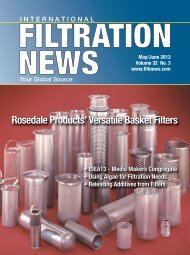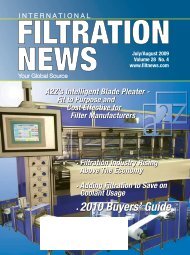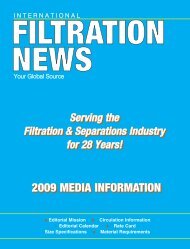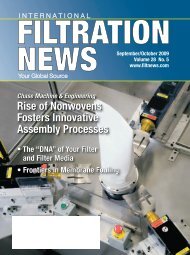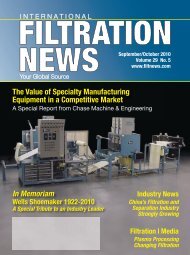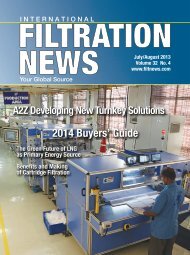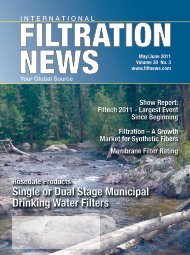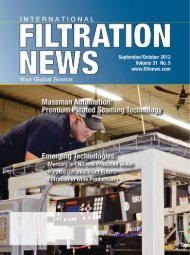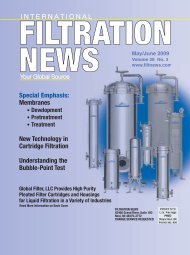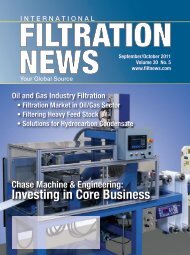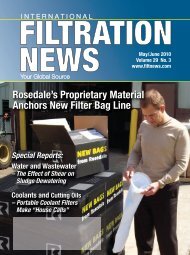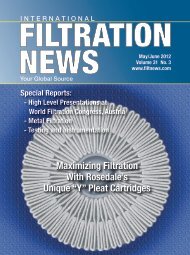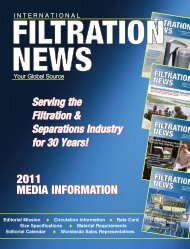2011 Buyers' Guide 2011 Buyers' Guide - International Fiber Journal
2011 Buyers' Guide 2011 Buyers' Guide - International Fiber Journal
2011 Buyers' Guide 2011 Buyers' Guide - International Fiber Journal
- No tags were found...
You also want an ePaper? Increase the reach of your titles
YUMPU automatically turns print PDFs into web optimized ePapers that Google loves.
Filter | Sterilizationchallenged with the organism. Thismethod exposes the filter to the productunder worst-case conditions andthen challenges the filter under conditionswhere the challenge organism cansurvive. These same considerationsmust be addressed for assay filters usedin the validation testing as well. Theuser may also decide to use a surrogatefor the challenge portion of the recirculationtest. If the product andprocess is found to not be toxic, thenthe preferred method of directly inoculatingthe product should be used. Inthis case, the product is directly inoculatedwith an appropriate amount of thechallenge organism and the conditioningand challenge are performed concurrentlyusing worst case processingparameters.Surface Tension: The presence ofsurface active ingredients may interferewith the bacterial retention mechanismof the filter, especially if the bacteria aresmaller than the smallest pore in the filter.Recent research has shown thatsieving action may not be the primaryretention mechanism in membrane filtration.Any phenomenon that mightinterfere with other filtration mechanismsmust be considered in the validationprocess. The change in thebubble point for the filter by the drugproduct does not, by itself, indicate areduction in bacterial retention, butmight be an indicator of the presenceof surface-active ingredients.Pressure and Flow Rate: Scientificliterature confirms that pressure canhave an effect on bacterial retention.Log reduction values decreased as thepressure increased in research by Leahy.The FDA therefore recommends validationunder worst case processingconditions (i.e., highest differentialpressure) to demonstrate bacterial retention.In the traditional test system,the interconnecting tubing diameter issomewhat non-variable so that in scaledown procedures, pressure and flowrate become interdependent. We haveconstructed our test apparatus withoversized tubing in order to eliminateas well as possible any flow rate limiting.In most validations, rate of flowper filter surface area is adjusted tomatch that of the actual process. Werecommend validations at the highestflow rate on the assumption that theseconditions will also result in the highestpressure differential. The recordeddifferential pressure may be higher orlower than the actual process pressure.Temperature: From a bacterial challengeperspective, temperature canhave a significant effect on the viabilityand recoverability of the microorganismsselected for the challenge. Thechallenge organism (Brevundimonasdiminuta) has a relatively narrow temperaturerange for maintaining viability.Thermal shock to the challengeorganisms could reduce the recoveryprocess. A re-circulating test can beused in cases where the process temperaturedoes not permit the challengeorganisms to survive. The drug productis re-circulated through the filter at the18 • August 2010 • www.filtnews.comelevated temperature for the prescribedduration to simulate temperature exposure.Retention testing is then conductedon the filter and cooled down toa temperature which will preserve theorganism’s viability.Duration: It has been demonstratedthat bacteria can migrate through filtersin use for extended periods of time.While the mechanism for this migrationis not clear, it is suggested that filtrationprocesses do not exceed 24hours in length. Validations for longerprocesses usually involve proceduresfor replenishment of the challenge andinterim samples to ascertain bacterialbreakthrough.Filter Selection and Integrity Testing:The microbial retention is normallyperformed on at least threefilters, each from different manufacturinglots. It is recommended that at leastone of those filters be at or near the filtermanufacturer’s recommended minimumbubble point as the user is limitedto using filters that match or exceed thelowest bubble point in the validation.Normally the integrity test is performedbefore and after the microbial challenge.There should not be a significantchange in the integrity test results afterthe microbial challenge has takenplace. Significant changes in integritytest results before and after the microbialchallenge could indicate occlusion,swelling, caking, precipitate, etc.The test procedure/validation consistsof testing at least three filters fromdifferent manufacturing lots. Each testfilter is challenged with a suspension ofBrevundimonas diminuta ATCC#19146 that has been cultured to maximizethe percentage of organisms capableof passing through a typical 0.45µm filter. Sufficient volume of this challengesuspension, equivalent to at least1 x 107 CFU/cm 2 of effective filtrationarea (EFA) is prepared for each filter.The challenge is conducted at a highflow rate and/or at a maximum differentialpressure consistent with worst



